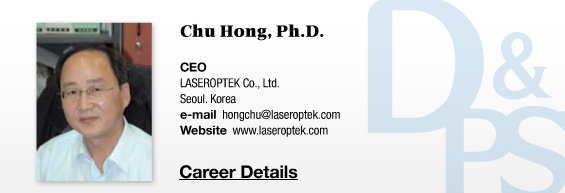Laser hair removal, which opened a new era for dermatologic laser, was discovered by sheer chance during tattoo removal with a Q-switched ruby laser. It was found that while removing tattoo with a ruby laser in guinea pig skin, hair shafts disappeared and the number of hair roots decreased. Clinical results of laser hair removal were reported by Dover et al. in 19894. Afterwards, Grossman used a ruby laser with a pulse duration of 270us (microseconds: 10-6 seconds) for hair removal in 13 patients. A 2-year follow-up showed 4 patients experienced drastic hair removal. Based on such results, FDA gave the Q-switched Nd:YAG laser (ThermoLase’s SoftLight) first approval for use in hair removal in 1995. At the time SoftLight did not have sufficient safety and efficacy data and required rubbing carbon particles on the skin to work as chromophores in hair follicles.
The principle is that laser is absorbed into carbon, which raises the temperature and causes thermal damage to hair roots. This was shown to be ineffective in clinical studies. In 1995, Goldberg found that hair removal with a Q-switched Nd:YAG laser had about 25% efficacy5. However, media started to tout laser as a permanent hair removal device and many doctors started to offer laser hair removal. In 1997, clinical results showing that 100% permanent hair removal is not possible6 were released and many doctors faced lawsuits in 1998. In 2000, ThermoLase disappeared from the market.
HELIOSⅡ/LOTUSⅡ/HYPERION – Manufacturer: LASEROPTEK(www.laseroptek.com)
In 1997, FDA approved for hair removal long-pulsed alexandrite laser (755nm) that targets melanin of hair roots. The long pulsed diode laser (810nm) and long pulsed Nd:YAG laser were each approved for hair removal 1998 and 1999. Unlike the Q-switched laser, long pulsed lasers produce strong heat upon irradiation and the epidermis needs to be protected from damage. Therefore, the hand piece started to have a more ergonomic design for convenience of use and various useful methods of cooling the epidermis were proposed. This helped enhance treatment outcome and reduce side effects.
Treatment protocols were optimized thanks to extensive research conducted on FDA approved lasers since 1997.
In 1993, Fitzpatrick used an improved CO2 laser with 500mJ and 1ms pulse duration to create a thermal coagulation zone of 50-100um (compared to previous 1mm) and showed that re-epithelization was achieved within 10 days7. This study established CO2 laser as the gold standard of laser resurfacing. However, many subsequent studies pointed out a long-term post-treatment erythema and delayed depigmentation. To compensate for such drawbacks, nonablative laser was proposed. The nonablative laser does not damage the epidermis while heating the dermal collagen and stimulates fibroblasts to induce collagenesis. This new method is called noninvasive resurfacing, skin toning or photorejuvenation. In 1999, a 1320nm Nd:YAG laser was developed to allow nonablative dermal remodeling and served as an important stepping stone toward development of Fraxel laser (Er:Glass fiber laser, wavelength: 1540nm) in the 2000s as well as the 1450nm diode laser and 440nm Nd:YAG laser.

Table 1. History of laser development in the1990s.
References
1. Fitzpatrick, T.B., The Validity and practicality of sun reactive skin types I through VI. Arch Dermatol 124;869-871
2. Watanabe S, Takahashi H, Treatment of nevus of Ota with the Q-switched ruby laser. N. Engl. J. Med. 1994;331;1745-50.
3. Harue Suzuki, Clinical Use of the Q-Switched Nd:YAG Laser for Treatment of Dermal and Epidermal Pigmented Lesions. The 8th Congress of International YAG laser Symposium
4. Dover JS, Margolis RJ, Polla LL, et al. Pigmented guinea pig skin irradiated with Q-switched ruby laser pulses, Morpholoic and historical finding, Arch Dermatol. 1989;125:43-9.
5. Goldberg DJ, Littler C. Topical solution Assisted Laser Hair removal, Lasers Surg. Med.1995;15:47
6. Nanni CA, Alster TS. Optimizing treatment parameters for hair removal using a topical carbon based solution and 1064-nm Q-switched neodymium:YAG laser energy. Archives of Dermatology 1997 Dec;133 (12):1546-9.
7. Fitzpatrick RE. The Ultrapulse CO₂ laser: selective photothermolysis of epidermal tumors. Laser Surg. Med. Suppl. 1993;5:56
-To be continued-





















